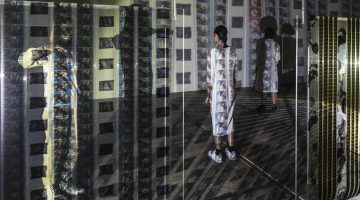By Glen Helfand

“Light Study, (Chantel Ackerman’s Jeanne Dielman, 23 quai du Commerce, 1080 Bruxelles)” 2012. 100w Light Bulb & Mixed Media, 201 min. An entire feature film’s averaged light levels as viewed
through the shifting brightness of an 100 watt light bulb. Photograph by Phil Bond. Courtesy of the artist.
It’s difficult to resist cinematic seduction, and Michael Mersereau doesn’t bother to try. His primary art interest is in tackling film’s multimedia channels, that fusion of time, space, and narrative. He is a formalist who revels in cinematic genres as much as the materiality of the medium. This recent Mills College grad gets away with tackling revered iconic films by dealing with them as objects—for their layering of tracks, the conglomeration of visuals, lighting, composition, sound, editing, and scripting. He separates and reconfigures these elements in ways that are lovingly surgical. That is not to say he repairs them, rather, he opens them up and finds his own way into their structure.

“Reverse view”, 2012. Single channel video, 8 min. 15 sec. A mundane drive where something is not quite right in our rear view mirror. “Reverse view” is an experimental dedication to driving in film, exaggerating the ordinary through cinematic production. Courtesy of the artist.
His “Light Study: (Jeanne Dielman, 23 quai du Commerce, 1080 Bruxelles, 201minutes, 1975)”, 2012 is succinctly described on the artist’s website as “An entire feature film’s averaged light levels as viewed through the shifting brightness of a 100 watt light bulb.”
He has taken Chantal Ackermann’s career-making opus, and fed it through a computer program that does this trick. As an installation, it’s a bare bulb hanging in a dark room, a flickering illumination that responds to the illumination of each scene, in which the amazing Delphine Seyrig going from room to room, shutting lights to save on her electric bill, as she dourly turns tricks. We’re cast into the light and dark of this almost dialog free, minimalist feature. Ackermann managed to tell a whole lot with minimal means (albeit a necessarily luxurious running time); Mersereau’s single gesture is astutely deployed to rethink a classic with only sound and light, the essential ingredients of every film.

“Reverse view”, 2012. Single channel video, 8 min. 15 sec. A mundane drive where something is not quite right in our rear view mirror. “Reverse view”
is an experimental dedication to driving in film, exaggerating the ordinary through cinematic production. Courtesy of the artist.
He has dared to mess with another masterwork in Sound Replacement for Dario Argento’s ‘Suspiria’, 2012, an audio/video piece in which he recreates the ambient soundtrack for the feature length of the stylized horror staple. Inspired, perhaps, by the strange sense of dubbing in 1970s Italian-made internationally distributed titles think the odd audio of Fellini’s mid-period, Mersereau replaced each scene’s sound with tones gathered on his own. For an opening airport sequence, he inserts the hum of whooshing electric doors and wind at SF International, gathering other ambient noises in buildings and streets in Montreal (he lives and works in the Bay Area and Quebec). The results are uncanny, a strange, dialog free quietude that alters the dramatic arc. Argento’s is a film of brilliant artifice and a notable, anxiety-spiking soundtrack by the prog rock band Goblin. There are beautifully bloody murders, broken glass, blood spilling on vibrantly hued shag carpets. The original film is over the top, but in Sound Replacement, it is calmed, tamped down to something we have to consume meditatively. In space, no one can hear you scream.
He works with the illusion of rear screen projection in the video “Reverse View”, 2012. In front, there’s a ride through city to country, in the rear view mirror, there’s a trip through another landscape. It’s a scenario that’s vertiginous yet as familiar as any color saturated old movie. Mersereau revels in the ways that we are tricked into a sense of dramatic narrative. Is it a car chase or a dull ride home? We essentially go nowhere, a static, simultaneous forward and back that thrillingly affirms that the medium can take us anywhere.
This article was selected from Issue 13 of SFAQ.



